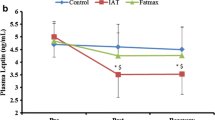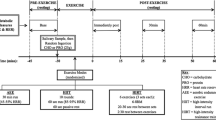Abstract
Nesfatin-1 is a recently discovered anorectic protein derived from posttranslational processing of the nucleobindin 2 (NUCB2) gene. It is expressed in adipose tissue and is also found in plasma. Nesfatin-1 expression is significantly affected by nutritional status and its actions may be involved in the inhibition of the orexigenic effect of ghrelin. Although the effects of physical exercise on several anorectic and orexigenic hormones have been reported, no studies have investigated its effects upon circulating concentrations of nesfatin-1. We investigated the effects of acute strenuous interval exercise and circuit exercise on nesfatin and other hormones affected by metabolic stress. Fourteen provincial and national level young male-kickboxing volunteers participated [age 20.71 ± 2.6 years, height 176.6 ± 2.8 cm, body weight 67.2 ± 3.3 kg, and body mass index (BMI) 21.56 ± 1.42 kg/m2]. After an overnight fast, responses to a running-based anaerobic sprint test (RAST; 7 sets of 6 × 35 m every 10 s with 1 min rest in between sets) and a non-combat kickboxing session (NCKB; 7 sets of 6 techniques, 20 s per technique with 1 min rest in between sets) were determined. Venous blood samples were collected before, immediately after, and 45 as well as 95 min following the exercises. Plasma GH, insulin, glucose and lactate concentrations significantly increased immediately following the RAST and NCKB protocols, however, plasma nesfatin-1 concentrations were not significantly altered. Higher plasma cortisol and glucose concentrations occurred in response to the RAST compared with the NCKB protocols. Although the exercise protocols elicited metabolic stress that significantly altered circulating glucoregulatory hormones, plasma glucose and lactate, there was no significant change in plasma nesfatin-1. A lack of nesfatin-1 response to the exercise protocols may be partially due to the fasting condition.



Similar content being viewed by others
References
Aydin S, Dag E, Ozkan Y, Erman F, Dagli AF, Kilic N, Sahin I, Karatas F, Yoldas T, Barim AO, Kendir Y (2009) Nesfatin-1 and ghrelin levels in serum and saliva of epileptic patients: hormonal changes can have a major effect on seizure disorders. Mol Cell Biochem 328:49–56
Brailoiu GC, Dun SL, Brailoiu E, Inan S, Yang J, Chang JK, Dun NJ (2007) Nesfatin-1: distribution and interaction with a G protein-coupled receptor in the rat brain. Endocrinology 148:5088–5094
Brema I, Hatunic M, Finucane F, Burns N, Nolan JJ, Haider D, Wolzt M, Ludvik B (2008) Plasma visfatin is reduced after aerobic exercise in early onset type 2 diabetes mellitus. Diabetes Obes Metab 10:600–602
Cowley MA, Grove KL (2006) To be or NUCB2, is nesfatin the answer? Cell Metab 4:421–422
Dill DB, Costill DL (1974) Calculation of percentage changes in volumes of blood, plasma, and red cells in dehydration. J Appl Physiol 37:247–248
Foo KS, Brismar H, Broberger C (2008) Distribution and neuropeptide coexistence of nucleobindin-2 mRNA/nesfatin-like immunoreactivity in the rat CNS. Neuroscience 156:563–579
Ghanbari-Niaki A, Saghebjoo M, Rahbarizadeh F, Hedayati M, Rajabi H (2008) A single circuit-resistance exercise has no effect on plasma obestatin levels in female college students. Peptides 29:487–490
Ghanbari-Niaki A, Abednazari H, Tayebi SM, Hossaini-Kakhak A, Kraemer RR (2009a) Treadmill training enhances rat agouti-related protein in plasma and reduces ghrelin levels in plasma and soleus muscle. Metabolism 58:1747–1752
Ghanbari-Niaki A, Fathi R, Kakhak SA, Farshidi Z, Barmaki S, Rahbarizadeh F, Kraemer RR (2009b) Treadmill exercise’s reduction of agouti-related protein expression in rat liver. Int J Sport Nutr Exerc Metab 19:473–484
Gluck ME, Geliebter A, Hung J, Yahav E (2004) Cortisol, hunger, and desire to binge eat following a cold stress test in obese women with binge eating disorder. Psychosom Med 66:876–881
Goebel M, Stengel A, Wang L, Lambrecht NW, Taché Y (2009) Nesfatin-1 immunoreactivity in rat brain and spinal cord autonomic nuclei. Neurosci Lett 452:241–246
Haus JM, Solomon TP, Marchetti CM, O’Leary VB, Brooks LM, Gonzalez F, Kirwan JP (2009) Decreased visfatin after exercise training correlates with improved glucose tolerance. Med Sci Sports Exerc 41:1255–1260
Inhoff T, Mönnikes H, Noetzel S, Stengel A, Goebel M, Dinh QT, Riedl A, Bannert N, Wisser AS, Wiedenmann B, Klapp BF, Taché Y, Kobelt P (2008) Desacyl ghrelin inhibits the orexigenic effect of peripherally injected ghrelin in rats. Peptides 29:2159–2168
Jürimäe J, Rämson R, Mäestu J, Purge P, Jürimäe T, Arciero PJ, von Duvillard SP (2009) Plasma visfatin and ghrelin response to prolonged sculling in competitive male rowers. Med Sci Sports Exerc 41:137–143
King NA, Burley VJ, Blundell JE (1994) Exercise-induced suppression of appetite: effects on food intake and implications for energy balance. Eur J Clin Nutr 48(10):715–724
King NA, Lluch A, Stubbs RJ, Blundell JE (1997) High dose exercise does not increase hunger or energy intake in free living males. Eur J Clin Nutr 51(7):478–483
Kohno D, Nakata M, Maejima Y, Shimizu H, Sedbazar U, Yoshida N, Dezaki K, Onaka T, Mori M, Yada T (2008) Nesfatin-1 neurons in paraventricular and supraoptic nuclei of the rat hypothalamus coexpress oxytocin and vasopressin and are activated by refeeding. Endocrinology 149:1295–1301
Kraemer RR, Acevedo EO, Synovitz LB, Hebert EP, Gimpel T, Castracane VD (2001) Leptin and steroid hormone responses to exercise in adolescent female runners over a 7-week season. Eur J Appl Physiol 86:85–91
Manshouri M, Ghanbari-Niaki A, Kraemer RR, Shemshaki A (2008) Time course alterations of plasma obestatin and growth hormone levels in response to short-term anaerobic exercise training in college women. Appl Physiol Nutr Metab 33:1246–1249
Merali Z, Cayer C, Kent P, Anisman H (2008) Nesfatin-1 increases anxiety- and fear-related behaviors in the rat. Psychopharmacology (Berl) 201(1):115–123
Oh-I S, Shimizu H, Satoh T, Okada S, Adachi S, Inoue K, Eguchi H, Yamamoto M, Imaki T, Hashimoto K, Tsuchiya T, Monden T, Horiguchi K, Yamada M, Mori M (2006) Identification of nesfatin-1 as a satiety molecule in the hypothalamus. Nature 443:709–712
Price CJ, Samson WK, Ferguson AV (2008) Nesfatin-1 inhibits NPY neurons in the arcuate nucleus. Brain Res 1230:99–106
Shimizu H, Ohsaki A, Oh-I S, Okada S, Mori M (2009) A new anorexigenic protein, nesfatin-1. Peptides 30:995–998
Stengel A, Taché Y (2009) Regulation of food intake: the gastric X/A-like endocrine cell in the spotlight. Curr Gastroenterol Rep 11:448–454
Acknowledgments
This work was supported and funded by the research office of University of Mazandaran and Faculty of Physical Education and Sports Science. We wish to thank Mr. Saber Akbarzadeh (Coach of the Sorkhrood and Shomal University Kick-Boxing Team) and his athletes for their kind help and sincere cooperation.
Author information
Authors and Affiliations
Corresponding authors
Additional information
Communicated by Susan Ward.
Rights and permissions
About this article
Cite this article
Ghanbari-Niaki, A., Kraemer, R.R. & Soltani, R. Plasma nesfatin-1 and glucoregulatory hormone responses to two different anaerobic exercise sessions. Eur J Appl Physiol 110, 863–868 (2010). https://doi.org/10.1007/s00421-010-1531-6
Accepted:
Published:
Issue Date:
DOI: https://doi.org/10.1007/s00421-010-1531-6




